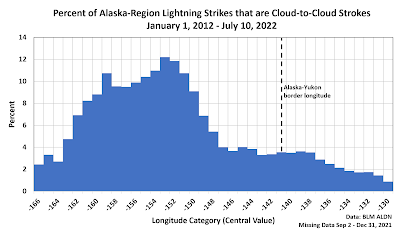I've been spending a bit of time working with Alaska's lightning data recently. Part of the goal is to have a history of daily lightning strike counts that is consistent with the 6am-6am numbers displayed on the BLM dashboard each day:
https://blm-egis.maps.arcgis.com/apps/dashboards/a23a625f4d18412ea13cffeefcbe7f5e
The analysis reveals that the current stretch of 10 consecutive days (including today) with over 5,000 lightning strikes is easily the most since the current detection network came into operation in 2012. The previous record was 6 days in June 2015. The late June 2015 lightning onslaught was massive, including over 56,000 strikes in 3 days; we haven't seen those kind of numbers yet this year, but in contrast there's been a more sustained period of heavy lightning activity in the past 10 days.
The BLM lightning data distinguishes between cloud-to-ground and cloud-to-cloud lightning strikes, so naturally I thought it would be interesting to examine the relative frequency. This reveals something quite surprising: nearly all of Alaska's cloud-to-cloud lightning occurs in the western half of the overall lightning zone. Compare the maps below (note the different scales):
Why would the eastern interior be almost devoid of cloud-to-cloud lightning? I hypothesize that eastern interior thunderstorms may be typically smaller and more isolated (despite being common), and rarely grow large enough to generate cloud-to-cloud lightning, which occurs between different parts of large thunderstorms or between separate thunderclouds. In contrast, perhaps higher moisture levels in the western interior more often allows thunderstorms to grow upscale and merge into larger conglomerations that provide more opportunity for discharge within and between clouds.
Those who have spent more time than I have watching satellite imagery might be able to comment on whether this hypothesis is reasonable.
Here's the percent of cloud-to-cloud lightning as a function of longitude. We only have 10 years of data, but it's a pretty striking result (sorry).



No comments:
Post a Comment